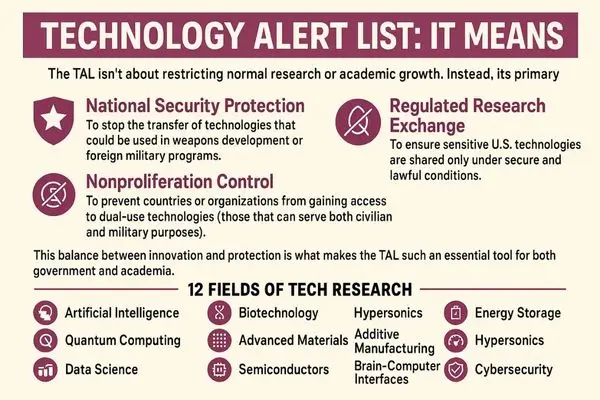In today’s world, technology is advancing at an unprecedented rate. From artificial intelligence to nuclear fusion, innovation knows no borders — but security still does.
Table of Contents
This is where the Technology Alert List (TAL) comes in. It plays a key role in protecting national interests while balancing the global exchange of scientific knowledge.
If you’re involved in tech research, work with sensitive materials, or plan to study in the U.S., understanding the TAL is crucial. This guide provides a clear and concise explanation of everything you need to know.
What Is the Technology Alert List (TAL)?
The Technology Alert List (TAL) is a security measure used by the U.S. government to monitor and control the transfer of sensitive technologies.
Its primary purpose is to prevent the spread of technologies that could be used to create weapons of mass destruction or advanced military systems.
In simple terms, the TAL is a list of scientific and technical fields that are considered “sensitive.” If a visa applicant’s research or work involves these areas, their visa application might receive extra scrutiny.
Purpose of the Technology Alert List
The TAL isn’t about restricting normal research or academic growth. Instead, its primary goals are:
- National Security Protection: To stop the transfer of technologies that could be used in weapons development or foreign military programs.
- Nonproliferation Control: To prevent countries or organizations from gaining access to dual-use technologies (those that can serve both civilian and military purposes).
- Regulated Research Exchange: To ensure sensitive U.S. technologies are shared only under secure and lawful conditions.
This balance between innovation and protection is what makes the TAL such an essential tool for both government and academia.
Technology Solutions Professional: Guide + 5 Key Responsibilities
Who Uses the TAL — and How?
The Technology Alert List is mainly used by U.S. consular officers and immigration authorities. When someone applies for a U.S. visa (like a student, researcher, or scientist), consular officers review their background, field of study, and affiliations.
If their work relates to any area listed on the TAL, the visa application may be flagged for further review through the Visa Mantis program — a type of security clearance that checks for potential risks in technology transfer.

Fields Covered by the Technology Alert List
The TAL encompasses a broad range of scientific and technological disciplines, including numerous cutting-edge fields. Some of the most notable include:
- Advanced Computer and Microelectronic Technology
- – Includes semiconductors, microprocessors, and AI systems used in defense or space applications.
- Nuclear Technology and Engineering
- – Covers nuclear reactors, fusion energy, and radioactive material handling.
- Materials and Manufacturing Technology
- – Advanced composites, alloys, and nanomaterials that can be used for aerospace or military applications.
- Aerospace and Rocket Technology
- – Satellite systems, propulsion technologies, and missile components.
- Biotechnology and Genetic Engineering
- – Research in synthetic biology or bioweapons-related materials.
- Conventional Munitions and Weapons Systems
- – Technologies related to firearms, explosives, or tactical systems.
Essentially, the TAL focuses on dual-use technologies — those that have both civilian and military applications.
How the TAL Affects Visa Applicants
If your field of study or work appears on the TAL, this doesn’t mean your visa will be rejected — but it may take longer to process.
Here’s what can happen:
- Your application may be subject to a Visa Mantis security review.
- You may need to provide extra documents about your research, employer, or institution.
- The approval time could extend from a few weeks to several months.
The goal is not to deny legitimate researchers, but to ensure that sensitive U.S. technologies are not transferred to entities that could misuse them.
Electric Vehicles Demystified: The Ultimate easy Guide
Consequences and Delays
A visa flagged under the TAL might face administrative processing delays, which can affect:
- Research deadlines or conference participation
- University admission timelines
- Employment start dates
If you’re an international researcher, it’s best to prepare early and consult your host institution’s international office. Providing clear and transparent information about your research helps avoid unnecessary delays.
How Researchers Can Stay Compliant
Here are a few practical steps to avoid issues with the Technology Alert List:
- Understand Your Field: Know if your area of study falls under sensitive categories.
- Be Transparent: Clearly explain your research purpose in visa applications and interviews.
- Work with Your University: Ask your international office or supervisor to provide the necessary documentation.
- Avoid Dual-Use Projects Without Clearance: If your research could have military applications, get the necessary permissions.
Following these steps shows good faith and helps ensure smooth visa approval.
Why the TAL Matters in 2025 and Beyond
As global innovation accelerates, technology security has become more critical than ever.
Emerging fields, such as quantum computing, AI-driven defense systems, and nanotechnology, now blur the line between civilian and military applications.
The Technology Alert List serves as a safeguard, ensuring responsible research collaboration between nations while protecting sensitive discoveries from misuse.
For global researchers and students, understanding TAL is not about restriction — it’s about awareness and compliance.
Final Thoughts
The Technology Alert List is a crucial component of how the U.S. manages global tech exchanges safely.
It might sound complex, but at its core, it’s about protecting innovation while promoting international cooperation.
If your field involves sensitive technologies, knowing how TAL works can save you time, stress, and confusion.
For universities, researchers, and innovators, awareness of the list is a sign of professionalism and global responsibility.